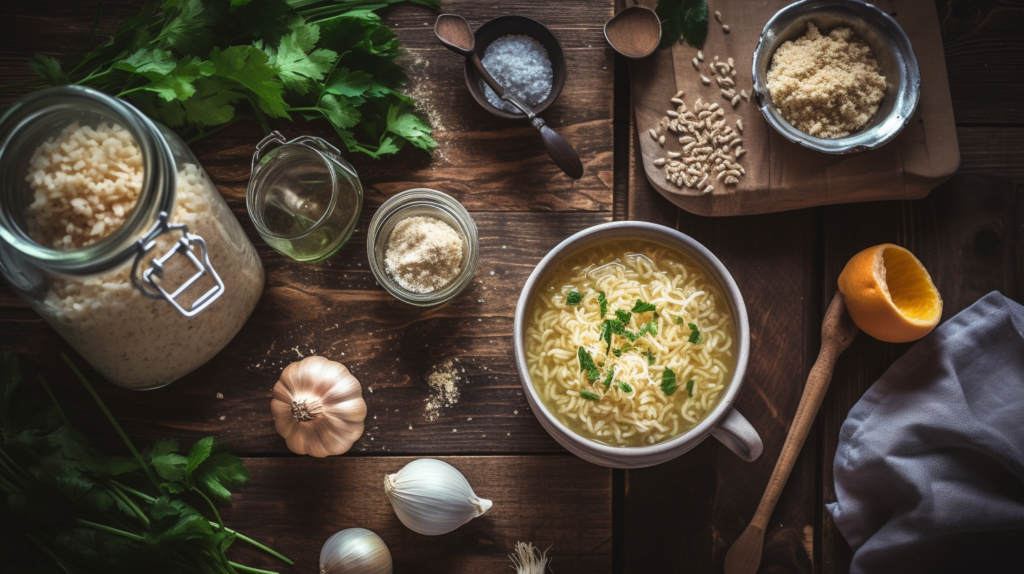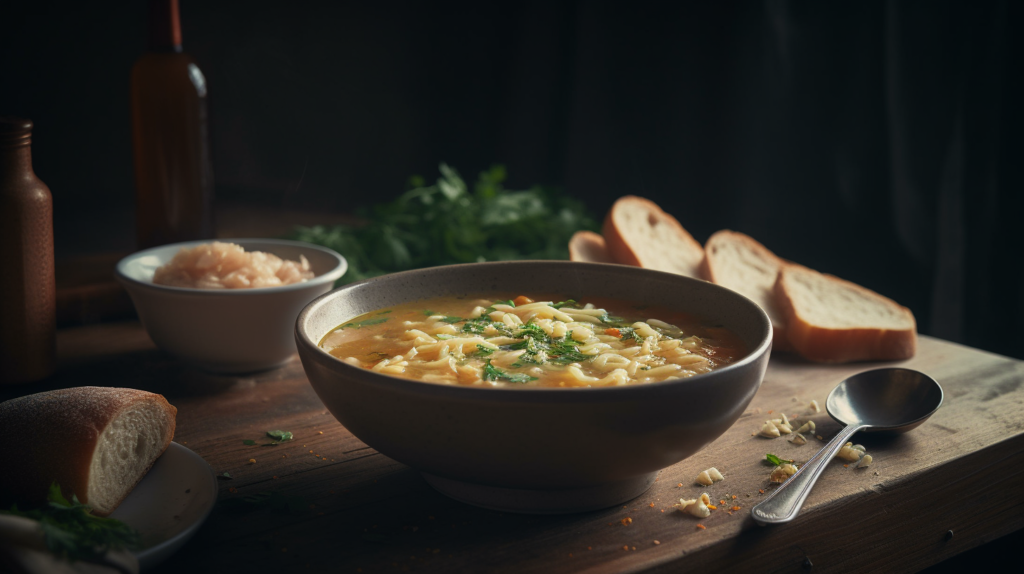Table of contents
Pastina soup is the epitome of simple yet satisfying comfort food. Originating from Italian kitchens, this timeless dish features tiny pasta grains simmered in a light, flavorful broth. Known for its nourishing qualities, pastina soup has been cherished for generations as a remedy for cold days, cozy evenings, or moments when you need a warm hug in a bowl.
The beauty of pastina soup lies in its versatility. Whether you prefer a rich, creamy finish or a lighter version with fresh herbs, this dish can be tailored to suit your taste buds. Its delicate flavors appeal to all ages, making it a family favorite across the globe.
Stay tuned as we explore its origins, essential ingredients, expert tips, and creative variations to elevate your pastina soup experience.
The Origins of Pastina Soup
The Origins of Pastina Soup
Pastina soup comes from the heart of Italian cooking, where simple recipes with quality ingredients take center stage. This dish has long been a favorite in Italian homes. Families loved its ability to transform pantry staples into a meal full of warmth and comfort. The word pastina means “little pasta,” which perfectly describes the tiny pasta shapes that form the base of this soup.
Traditional Roots
In the past, Italian families often made pastina soup for children, older adults, or anyone feeling unwell. It was easy to digest and packed with nourishment. The tiny pasta pieces made it simple to prepare, while ingredients like eggs, cheese, or herbs added flavor and nutrition. Grandmothers, or nonne, passed the recipe down through generations, making it a treasured tradition.
Italian cooks were resourceful. They saved meat or vegetable scraps to make broth, ensuring nothing went to waste. Adding pastina turned these broths into satisfying meals that filled stomachs without heavy ingredients. Each region in Italy added its unique twist to the recipe, showing how adaptable this dish could be.
Modern Variations
Today, pastina soup remains popular but has taken on new forms. Some modern recipes use creamy textures with milk or cheese, while others opt for plant-based broths. Creative cooks might add vegetables, beans, or other pasta shapes for variety. However, the dish’s simplicity and comforting nature have not changed.
Even with these variations, pastina soup remains a timeless classic. It is a reminder of how humble recipes can create big smiles. Whether you make it the traditional way or with a personal twist, this dish always brings warmth and joy to the table.
Essential Ingredients for the Best Soup
Key Ingredients for a Delicious Bowl
The beauty of this soup lies in its simplicity. With just a few ingredients, you can create a comforting and flavorful meal. Here’s what you’ll need:
1. Small Pasta Options
The pasta is the heart of this dish. Traditional recipes use tiny pasta shapes, such as stars, alphabets, or small beads. If these are not available, you can substitute with any small-sized pasta like orzo or ditalini. The smaller the pasta, the better it soaks up the flavors of the broth, making every spoonful delightful.
2. Flavorful Broth Choices
A good broth can elevate the dish from ordinary to exceptional. For a lighter version, vegetable stock works wonderfully. Homemade broth, simmered with onions, carrots, and celery, adds a deeper flavor. If you want something richer, you can use chicken stock. Whatever you choose, make sure it’s seasoned well for the best results.
3. Additions to Boost Nutrition
While traditional recipes keep it simple, you can add a variety of ingredients to suit your taste. A whisked egg, stirred in while the soup is hot, gives it a creamy texture. Grated cheese, like Parmesan or Pecorino, adds a savory touch. Leafy greens such as spinach or parsley bring freshness and added nutrients. These small tweaks can make your soup even more satisfying.
Tips for Choosing Ingredients
- Opt for fresh, quality ingredients. Simple recipes rely on the best flavors from their components.
- Don’t overcomplicate—less is more with this dish.
- Taste the broth before adding pasta to ensure it’s well-seasoned.
How to Make the Perfect Pastina Soup
Step-by-Step Instructions for Cooking Pastina Soup
Making pastina soup is a simple and rewarding process. Follow these easy steps to create a warm and comforting bowl that everyone will love.
1. Prepare Your Ingredients

Start by gathering all your ingredients. You’ll need:
- Tiny pasta (such as pastina, orzo, or another small variety)
- Broth of your choice (vegetable, chicken, or homemade)
- Optional additions: grated cheese, whisked egg, or fresh herbs
Measure out your pasta and ensure your broth is hot and ready for use. Preparing everything beforehand ensures a smooth cooking process.
2. Cook the Broth
In a large pot, bring your broth to a gentle boil. This forms the base of your soup, so taste and adjust the seasoning as needed. Add a pinch of salt or a splash of olive oil to enhance the flavor. If you’re using a homemade broth, simmer it with herbs like thyme or bay leaves for extra aroma.
3. Add the Pasta
Once your broth is simmering, gradually add the pasta. Stir frequently to prevent it from sticking to the bottom of the pot. Cooking times may vary based on the type of pasta you’re using, so follow the package instructions. Be careful not to overcook; the pasta should be tender but not mushy.
4. Customize the Soup
While the pasta cooks, consider adding optional ingredients to enhance your soup. Stirring in a whisked egg while the soup is hot will create silky ribbons throughout. A handful of fresh spinach or parsley can bring brightness and nutrition. For a savory finish, top each bowl with freshly grated Parmesan or Pecorino cheese.
5. Serve and Enjoy

Ladle the soup into bowls and serve it immediately. A drizzle of olive oil or a sprinkle of cracked black pepper can add a final touch. Pair it with a slice of crusty bread for a complete and satisfying meal.
Tips for Even Cooking
- Stir the soup occasionally to ensure the pasta cooks evenly.
- Keep an eye on the broth level; add more if it starts to reduce too much.
- Always taste before serving to confirm the flavors are balanced.
Tips for Perfecting Your Pastina Soup
Expert Advice for Making the Best Soup
While pastina soup is simple to prepare, a few expert tips can make your dish truly exceptional. Whether you’re cooking it for the first time or refining your technique, these suggestions will help you achieve a bowl that’s both flavorful and comforting.
1. Achieving the Perfect Texture
The texture of your soup depends largely on the pasta. Cook it just until tender—this usually takes only a few minutes, especially with small pasta shapes like pastina or orzo. Overcooked pasta can turn mushy and absorb too much of the broth, leaving the dish overly thick. To prevent this, monitor the cooking time closely and remove the pot from the heat as soon as the pasta is done.
2. Layering Flavors
A flavorful broth is the backbone of pastina soup. If you’re using store-bought stock, consider enhancing it with a few extra ingredients. Simmer the broth with a garlic clove, a sprig of thyme, or a bay leaf for added depth. For an umami boost, stir in a small amount of tomato paste or grated cheese while the soup cooks.
3. Balancing the Ingredients
Keep the balance of your soup in mind. The pasta should complement the broth, not overwhelm it. Use a 2:1 ratio of broth to pasta to maintain a light, soupy consistency. If you prefer a thicker version, you can add a bit more pasta, but be cautious not to overdo it.
4. Enhancing Presentation and Flavor
The way you serve pastina soup can elevate the experience. Garnish each bowl with freshly chopped parsley, a drizzle of olive oil, or a sprinkle of black pepper. Adding a wedge of lemon on the side can provide a refreshing contrast to the richness of the broth.
5. Storing and Reheating Tips
If you have leftovers, store them in an airtight container in the refrigerator for up to three days. However, keep in mind that the pasta will continue to absorb liquid over time. To restore the soup’s original consistency, add a bit of water or extra broth when reheating. Warm it gently on the stovetop to avoid overcooking the pasta.
Frequently Asked Questions and Conclusion
Common Questions About This Dish
1. What makes this dish so comforting?
The simplicity and warmth of the soup make it universally comforting. The tiny pasta absorbs the flavors of the broth, creating a smooth and satisfying texture. It’s a dish that’s easy to prepare yet full of heart.
2. Can I use any type of small pasta?
Yes, while pastina is traditional, other small pasta varieties like orzo, ditalini, or even broken spaghetti pieces can work just as well. The key is to use pasta that cooks quickly and holds its shape in the broth.
3. How do I make this meal kid-friendly?
For children, you can use fun-shaped pasta like stars or alphabets. Adding a little grated cheese or blending some vegetables into the broth can make the dish both appealing and nutritious for younger eaters.
4. Can I make this soup ahead of time?
This dish is best enjoyed fresh, as the pasta continues to absorb liquid if stored. However, if you need to prepare it ahead, cook the pasta separately and add it to the reheated broth just before serving.
5. What is the best way to store leftovers?
Store any leftover soup in an airtight container in the refrigerator for up to three days. When reheating, add a splash of broth or water to adjust the consistency and gently warm it on the stove.
6. Can I make a vegetarian version?
Absolutely! Use vegetable broth instead of chicken stock, and you’ll have a flavorful vegetarian option. Add some vegetables like carrots, zucchini, or spinach for extra nutrition.
Final Thoughts on This Comforting Recipe
Pastina soup is a timeless dish that brings joy and comfort to every table. Its simple ingredients and straightforward preparation make it a favorite for both novice and experienced cooks. Whether you stick to a classic recipe or try new variations, this soup is sure to become a staple in your home.
With its versatility and heartwarming qualities, this dish has earned its place as a go-to meal for cold days, cozy dinners, or moments when you need a little extra comfort. Now that you have all the tips and tricks, it’s time to grab your ingredients and create a bowl of your own. Enjoy!

